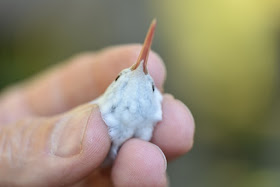On October 4th and 5th, Mark Armstrong, Master Bander of hummingbirds and songbirds, and Janie Kading traveled from Seymour, TN, to Oliver Springs, TN, to capture and band an albino Ruby-throated Hummingbird. Their second trip was successful!
The young female, hatched this summer and weighing 4.1 grams is pictured above and below in photos taken by Mark Armstrong to document her condition. In the image above you can see the dark red of her eye, and the lack of pigment in her beak, normally black in coloration.
Mark explains albinism this way: Albinism is a sex linked recessive characteristic and carried on the X chromosome. In birds males are XX and females XY, so if a female had the gene it would be expressed and if a male had the gene he could carry it as a recessive characteristic and look normal or if he inherited the characteristic from both parents the gene would be expressed and he would be albino.
"I think most likely our bird was the product of two normal birds but she would have inherited the trait from her father. There is a lot I don’t understand about the trait....This bird did have dark red eyes, pigment wasn’t present in the beak or feet. She did have dark bases to the feathers on the back however. In ruby-throats the trait is rare but there usually are a few every year. Leucistic is more common and those birds will have patches of white or overall a faded appearance. The genetics of that trait is more complex and involves the synthesis of melanin or turns it on or off in different areas of the plumage. It was 6 or 7 years ago I went after a white bird and asked Bob Sargent for some advice and if I should try to band it. He said sure, he had banded 100 or so but none have ever returned."
Mark adds, "They are pretty vulnerable. This bird reminded me of a cicada flying with those white wings flashing. Melanin actually strengthens the feathers so white birds tend to have worn plumage, this bird was actually in pretty good shape. She also weighed 4.1 grams so had a good fat load and was preparing to head out. I talked with the host yesterday and she did not see the bird the following morning."The image above captures the fairy-like quality of the hummer's tail feathers absent normal pigment. The absence of pigment allows feathers to wear rapidly, as well as, makes the hummingbird more visible to predators.
Photo credit: Kathy Townsend
Kathy and Tom Townsend were the hosts to this beautiful hummingbird in Oliver Springs. Kathy called her. Angel, and she writes the following: "This is the picture [above] I took the last time I saw Angel on Oct. 6th. She was truly a blessing from God and I am so thankful for the experience. I sure do miss seeing her. She was at our home for 9 days. It was a wonderful experience that I will never forget and what made it more special was when Mark put her in my hand after he had done the measuring and weighing, and I was able to let her fly. She stayed in my hand, it seemed like a minute, but I'm sure it was several seconds and then off she flew. I didn't think she would be back. I thought maybe she was traumatized from being captured, but she came back to the same feeder that evening. Then I knew that it is a harmless procedure and so well worth it." Kathy also reported that after speaking with Mark the next morning and reporting the hummer hadn't returned, she then saw the hummer later that morning. That was the last day the hummer was seen at their home.
In 2013, Cyndi and Steve Routledge hosted an albino Ruby-throated Hummingbird in Clarksville, TN. The images directly above and below were taken by Cyndi Routledge in her yard. Since that time, Cyndi has also become a Master Bander and bands hummingbirds and songbirds in Middle and West Tennessee and northern Mississippi. To see more images visit: Albino Ruby-throat
Links and Resources:
Visit this link to read more about Mark Armstrong and fall/winter hummingbird banding
More about summer hummingbird banding.
Mark Armstrong, Master Bander of songbirds and hummingbirds









How beautifu!!
ReplyDelete